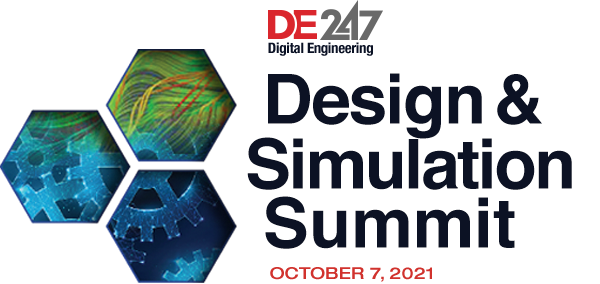DE Design & Simulation Summit Launches This Week!
Leading industry experts and Digital Engineering contributors headline the inaugural summit, which debuts online Thursday, Oct. 7.

Latest News
October 4, 2021
The countdown to the very first Digital Engineering online Design & Simulation Summit is getting shorter. For the one-day Summit this week (Thursday Oct.7), we put together a stellar lineup of knowledgeable speakers and informative presentations, to help you identify the right tools for your job and avoid the common pitfalls. Here are some highlights from the tracks.
You can find more details and registration information at the links below.
Keynote: Putting Digital Twins to Work
In the LIVE keynote session, researcher Michael Kapteyn from the Oden Institute for Computational Engineering and Science, University of Texas, looks at what it takes to create self-aware digital twins that are scalable for enterprise adoption. Furthermore, he discusses how mathematics, data, and physics models must come together to make the digital twin reliable enough for predictive purposes. Michael’s presentation includes a live Q&A session with the audience.
Session 1: The Myths and Realities of Generative Design
Joe Walsh, CEO and Cofounder of the ASSESS Initiative, and Dr. Andreas Vlahinos, CTO of Advanced Engineering Solutions, join forces to separate the myths and realities of Generative Design (GD). A champion of simulation democratization, Joe discusses the industry’s lack of consensus on what GD is, how it’s different from the classic topology optimization methods, and what the current incarnation’s shortcomings are. A veteran of the simulation software industry, Andreas explains how the users prefer to work with GD tools, what the GD software in the market allows you to do, and how to bridge the gap.
Session 2: How Can Designers Really Take Advantage of FEA?
Tony Abbey, Simulation Consultant, FEA Instructor for the industry group NAFEMS, and a regular contributor to Digital Engineering, discusses the two distinctly different approaches to simulation: the FEA-centric approach that revolves around FEA entities; and the CAD-centric approach that makes FEA tools accessible inside CAD programs. Comparing the two options, Tony offers his assessments on how different types of simulation users might employ these approaches. He also addresses the chicken-and-egg dilemma: To start your design, you need simulation data for guidance; but without a concept design, there’s nothing to simulate, so where do you begin?
Session 3: Designing for the Entire Additive Manufacturing (AM) Process
Is additive manufacturing (AM) the Holy Grail that will transform manufacturing and replace subtractive methods? Should you print something just because you can? Mark Barfoot, Director of Additive Manufacturing Programs, EWI, offers a reality check. To take advantage of AM, you must take into account what the technology can and cannot do; and be well-versed in what is called DfAM (Design for AM). From material consideration and AM-friendly topology to post-processing requirements, Mark explains how each component affects the cost and scope of the project.
Session 4: Configuring the Right Engineering Workstation
Choosing a workstation is not just about getting the fastest processor, the biggest hard drive, the largest memory allocation, and the strongest GPU. It’s a matter of balance, says David Cohn, Senior Content Manager for CADLearning products at 4D Technologies and DE’s resident hardware reviewer. In this track, David discusses how to match the workstations’ components to the type of software you run and the tasks you routinely execute. Is integrated graphics enough for your needs? Do you need a discrete GPU? What kind of RAM is better for your work? David tackles these questions and more.
Register for the entire Summit program here.
Subscribe to our FREE magazine, FREE email newsletters or both!
Latest News







.png)